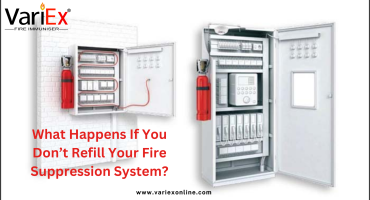![]()
Fire Immuniser
+91-7829629111
Email: info@variex.in
Varistor Technologies Pvt. Ltd.
Block-1, First Floor, Ardente Office One, Hoodi Circle, ITPL Main Road, Bengaluru, Karnataka 560048, IN
How To Wire A Commercial Fire Alarm System
How To Wire A Commercial Fire Alarm System
Fire alarm systems are crucial installations in commercial buildings as they help provide a first line of defense against the threat of fires. To ensure the optimal functioning of these life-saving devices, they must be accurately and professionally installed. This article will discuss the essential steps involved in wiring a commercial fire alarm system and the key considerations to bear in mind during the process. Remember that any work involving these systems should be conducted under the supervision of a professional, certified installer, as any installation of fire alarm systems is subject to local and national safety codes and regulations.
 Understand the System Components
Understand the System Components
Before commencing the actual wiring process, it is pivotal to understand the various components in a fire alarm system. A typical commercial fire alarm system consists of essential components like alarm initiating devices (such as smoke detectors and heat sensors), alarm notifying appliances (like sirens and strobe lights), control panels, and powering equipment like batteries and backup power sources. Familiarize yourself with the functions and interrelation of these components for an efficient installation process.
Fire Alarm Control Panel
Essentially, the Fire Alarm Control Panel serves as the heart of the system. This unit gets signals from initiating devices and triggers the notifying appliances in case of a potential fire. Most commercial fire alarm systems use addressable control panels, with each device having a unique address aiding fault detection and system management. This panel needs to be installed in a favorable and convenient location that is easily accessible.
Alarm Initiating Devices
The heat detectors and smoke detectors are the alarm initiating devices. These sensors detect abnormalities in heat and smoke levels and send information back to the control panel. Placement of these initiating devices varies as per the building's unique architecture and requirements, and they should be strategically wired around areas prone to fire outbreaks, such as kitchens and boiler rooms.
Alarm Notifying Devices
Once a potential fire signal is received by the control panel, the alarm notifying devices are activated. These include visible and audible alarms like sirens, bells, strobes, voice evacuation messages, etc. These appliances should be installed in high visibility areas and throughout the building to guarantee everyone is notified promptly in case of an emergency.
Powering Equipment
A robust powering structure should be set up to ensure uninterrupted functioning of the alarm system. Normally, the systems are wired into the building's electrical circuit. But as fire can potentially knock out the main power, it is necessary to have a battery backup to power the system during these instances. Further, regularly testing and replacing the batteries is an important part of maintaining a fire alarm system’s functionality.
Cable Selection
Selecting the right cable is vital. Fire alarm systems, especially in commercial buildings, need to use fire-resistant cables to withstand high temperatures. Two types of wires commonly used are power-limited fire alarm cable (FPL) and non-power-limited fire alarm cable (NPLF). The decision generally depends on the specific requirements of the system that your commercial building is installing.
Adhering to Standards and Regulations
The installation and wiring of commercial fire alarms are governed by numerous standards and regulations, for instance, those laid out by the National Fire Protection Association (NFPA). Adhering to these standards during the installation process ensures the safety and effectiveness of the system. It's also vital to regularly inspect and maintain these systems as per the local regulations and codes.
Professional Supervision
While understanding the process of wiring a fire alarm system helps in better management, it is always recommended that the actual installation and wiring process be conducted under the supervision of a professional or certified installer. They are equipped with the necessary skills and technical knowledge to ensure the system is set up correctly and up to code. Plus, they know how to handle unexpected issues that may arise during the installation process.
Conclusion
Wiring a Commercial Fire Alarm system requires a deep understanding of the structure, safety requirements, and codes of commercial buildings. While comprehending the steps involved is crucial for anyone working in a commercial environment, always leave the actual wiring process in the capable hands of certified professionals. Staying cautious and following guidelines not only ensures the safety of individuals but also contributes to the efficient functioning of a business by preventing avoidable emergencies. After all, when it comes to fire safety, there is no room for compromise or mistakes.
Final Say
At VariEx.in and VariexOnline.com, we specialize in supplying and installing top-quality fire fighting systems and equipment. From fire extinguishers to advanced suppression systems, we offer comprehensive solutions tailored to your needs. Our experienced team ensures precise installation and maintenance for optimal safety.
Trust VariEx for reliable fire protection. Contact us online or call 7829629111 to learn more.
"WHAT YOU CAN READ NEXT"
 Read more +24 November 2023 in Fire Extinguisher
Read more +24 November 2023 in Fire ExtinguisherWhat types of fire extinguishers are available for different fire classes?
 Read more +11 April 2025 in Fire Suppression
Read more +11 April 2025 in Fire Suppression






